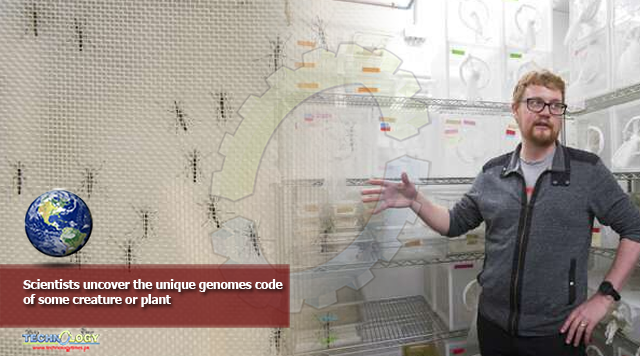They also announced that, thanks to a crowdfunding campaign, they’d produced the genomes of Lil BUB, a female cat with a large internet following.

Just about every week, it seems, scientists publish the unique DNA code of some creature or plant.
Just in February, they published the genome for the strawberry, the paper mulberry tree, the great white shark and the Antarctic blackfin icefish.
They also announced that, thanks to a crowdfunding campaign, they’d produced the genome of Lil BUB, a female cat with a large internet following.
That followed a notable advance in January: an improved genome for the axolotl, a salamander renowned for regrowing severed limbs and other body parts.
Scientists have been uncovering genomes for quite a while. The first from an animal — a worm — came in 1998. Now, the technology has advanced far enough that scientists last year announced a project to produce the genomes for all life forms on Earth other than bacteria and single-celled organisms called archaea. They called it a “moonshot for biology.”
But what’s the point of uncovering new genomes?
For scientists, a detailed look under the hood of their favorite organism provides a foothold for learning the deepest secrets of their objects of attention, it leads to discoveries about how life works, and possibly how to prevent disease.
Take the mosquito. Late last year, researchers published a much-improved description of the DNA code for a particularly dangerous species of mosquito: Aedes aegypti, notorious for spreading Zika, dengue and yellow fever.
That achievement came from analyzing the DNA of 80 mosquito brothers. They were born in Leslie Vosshall’s lab at Rockefeller University in New York, where thousands of mosquitoes swarmed in cages recently as Krithika Venkataraman was trying to make some more.
She stuck a tube that protruded from her mouth like a straw into a transparent cube filled with male mosquitoes. Then she repeatedly sucked about 30 males at a time into the tube. She counted them, and then blew them into another cube that housed females. Before long, the two sexes were mating.
You can think of a genome as an instruction book for building a living thing. Its language is a four-letter alphabet, which stand for the four compounds that make up the innards of the DNA molecule. The order of those compounds along the molecule is the code; it creates “words” that we call genes.
The mosquito genome, for example, is about 1.28 billion letters long, a bit less than half the length of the human version.
Knowing the DNA sequence lets scientists manipulate it with gene editing techniques, said Ben Matthews of the Vosshall lab, who was part of the international team that published the refined description of the mosquito genome last November.
And once researchers started analyzing that version of the DNA code, discoveries began to pop out.
— They nearly doubled the known size of a family of genes that help mosquitoes sense information from their environment, such as the odor of humans. That was “totally, mind-blowingly, unexpected,” Vosshall said. (Vosshall’s salary is paid by the Howard Hughes Medical Institute, which also supports The Associated Press Health & Science Department.)
Further study may reveal surprises about what mosquitoes pay attention to, Vosshall said. And that could lead to better lures for mosquito traps, as well as better repellents. Maybe scientists can find something “10,000 times more disgusting” to a mosquito than the old standby, DEET, she said.
— They found new details about genes that let some mosquitoes resist certain insecticides. That’s a possible step toward predicting what insecticides would be useless for fighting certain populations, as well as a potential lead for coming up with new chemical weapons against the insect.
They found previously unknown targets for a major class of insecticides. That could open the door to designing new versions that target mosquitoes while sparing beneficial insects and posing less risk to people.
They narrowed the search for genetic variants that prevent some Aedes aegypti mosquitoes from infecting people with dengue, a severe flu-like illness that sickens millions every year.
If those variants can be identified, scientists might use genetic engineering to reproduce them in some mosquitoes, which could then be released to spread the variants though wild populations, Vosshall said. Those variants, or others, might also work for reducing threats of spreading Zika and yellow fever, Vosshall and Matthews said.
— A similar strategy might be used to make mosquito populations overproduce males. That would reduce mosquito bites in the short term — only females bite — and open the door to shrinking wild populations through genetic engineering.
The new genome revealed details of the DNA stretch that makes mosquitoes develop as males, which Matthews called “step one” in pursuing the make-more-males strategy.
The salamander genome published in January built on a previous publication by European scientists last year. Although its genome is about 10 times the size of the human one, which makes the analysis harder, the axolotl’s regenerating capabilities are an obvious lure.
Axolotls can replace “almost anything you can cut off of them, as long as you don’t cut off their heads,” says Jeramiah Smith of the University of Kentucky in Lexington, an author of the more recent genomes paper.
But Smith points to another trick that might pay off sooner for human medicine: The salamander can also heal large wounds without scarring.
As for learning how to let people grow back a severed arm, he figures that’s a long way off.
“That probably won’t be useful for me,” joked Smith, who’s 42. “I’ll be dead, so I won’t need to grow my arm back.”
And Lil BUB ? She’s the size of a kitten even though she’s 8 years old, and has a number of other odd traits. Scientists looked for genetic mutations, and found altered genes that appear to be responsible for her extra toes and for a rare bone disease.
Originally published at AP news